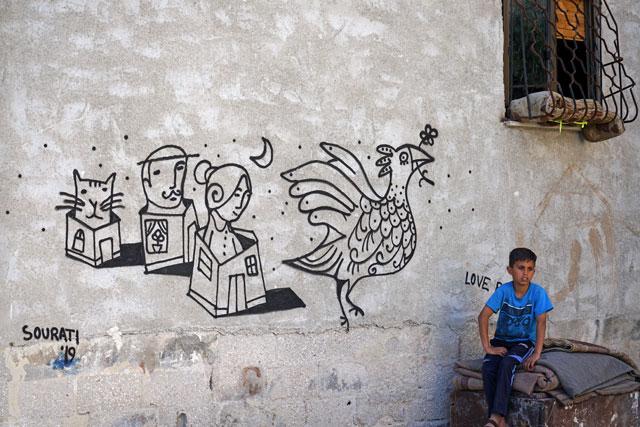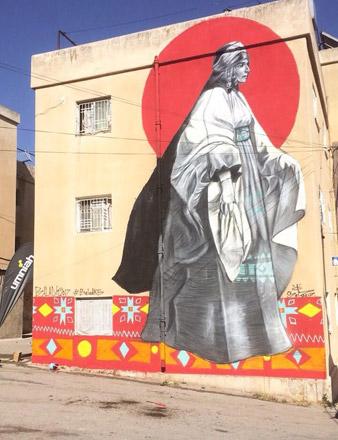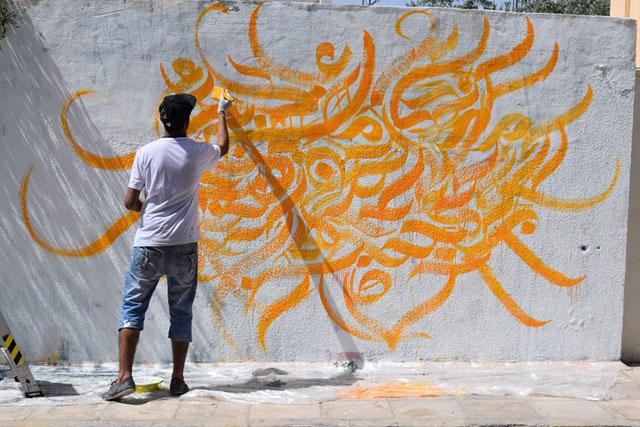You are here
Backed by locals, street art finds footing in Amman
By Yasmeen Kanaan - Jun 16,2019 - Last updated at Jun 17,2019

In this undated photo, a boy can be seen sitting in front of a mural painted by German artist Duo Sourati during the 2019 Baladk street art festival in Amman (Photo courtesy of Al Balad Theatre)
AMMAN — Street artist Suhaib Attar paints over his own mural as a new work is being born for the public during the Baladk street art festival. The act of erasing, he said, is nothing more than disruption, and that is how street artists work.
Change is a natural progression, which street artists use to fight the concept of ownership and exclusivity; turning art into a public and ephemeral form of expression.
As a reaction against art becoming institutionalised, street art was born to be available to all rather than accessible only by the privileged. Art became a tool to achieve democracy and empowerment, as people used it to share their own agendas, according to artists.
Street art defies the conventional approach by directly opening a conversation with the public and cutting out the middle man; which is usually a gallery or museum.
“Street art has different forms; graffiti, break dance, rapping, DJing and beatboxing. Graffiti originally began as a way to mark territories between street gangs and street art initially started from there,” Attar recently told The Jordan Times. “When artists realised this new school, they shifted from canvases to walls, blurring the lines between the niche and the public.”
Street art is a new approach in the Kingdom that is receiving plenty of support from the public, according to Jordanian artists.
“Jordan is a newborn child; it is still adapting as people are trying to get into street art. Generally, it is a golden age for the Jordanian art community. In street art, there is no closed community that controls the buyers and the sellers.” Attar said.
Attar, who started his career as a street artist in 2012, believes that public art has more responsibility than institutionalised art, as the public has a say in the content displayed.
“Since the artwork is aimed at the public, it is the artist’s responsibility to make it admired by the community... It doesn’t always have to carry your personal agenda, because the core of street art is expressing freedom, and when you do so, you are marking a point on a map that you are here.”
Attar argued that practical ownership of work is complicated. The artists should not be attached to the work as they cannot own more than their pride in making it.
What marks street art is not just the inability to be owned, but also the temporary nature of the work, said Rawaa Qudah, a rising artist who participated in the 2018 Baladk street art festival. “Street artists should keep in mind that whatever kind of effort they will put into the work, people and nature will eventually take their toll on it.”
Qudah added that what makes street art significant is that it is a meeting point between architecture and visual art.
“Both worlds collide to produce another dimension. I have respected the idea that you do not have to have a certain background to be welcomed into this world and that is what I wanted to be part of,” Qudah told The Jordan Times.
“Whoever is walking can actually see an unsanctioned place seem beautiful and meaningful. With my architectural background, I see street art as an integration of art into the public realm. My art is a form of contribution to the city, its identity and how the city is perceived.”
Since 2013, Al Balad Theatre has been a prominent supporter of Jordanian street art, according to local artists. On an annual basis, the theatre organises a street art festival to provide rising and established artists with the opportunity to produce their own murals.
“People have their own measures for what they will accept on their walls. If they don’t like the output, they might destroy the work or draw over it. In a sense, it is their right to express acceptance or rejection. People’s interaction with the work affects its life span”, Raed Asfour, director of Al Balad Theatre said.
Street art has also become a way to establish passionate relationships between art and children living in the suburbs, Asfour added. Today, Hay Al Graffiti in the Hashemi Shamali area is an art destination for tourists as well as locals.
When an artist is painting a mural, residents sometimes come out to help as well, according to Asfour, who said that in many cases, children assisting the artist gain credit for their work.
“The most beautiful experiences are when the artists are up on the cranes... It is very intimate. Artists are fed and served tea while they are up on the crane. Sometimes, sign language is used when neither the family nor the artist share a common language,” Asfour said.
The Jordanian art scene is being pushed forward as youth continue to gain exposure. However, in many cases, such progress is being limited to the capital city.
“Amman is a collective society, all activities in Jordan happen in Amman because it is the only place that has exposure to... globalism,” Qudah added.
However, the Jordanian art scene still has a promising future with more youth encouraged to join the street art community every year, Asfour said.
“When artists beautify the buildings, it reflects on the residents living there,” Asfour noted. “Today people are listing their buildings to be used by artists a year ahead of our next festival; it has become a form of pride for Jordanians.”
Related Articles
AMMAN — Amman’s cityscape was saturated with colour and hope as Italian street artist Millo kick-started the Baladk Street and Urban Art Fes
AMMAN — A number of graffiti artists have teamed up to decorate the pale walls of Amman, presenting a number of outdoor artworks for Ammanis
AMMAN — Foreign visitors to Amman often recalled being mesmerised by the colourful works of art covering the walls of the capital, designed














